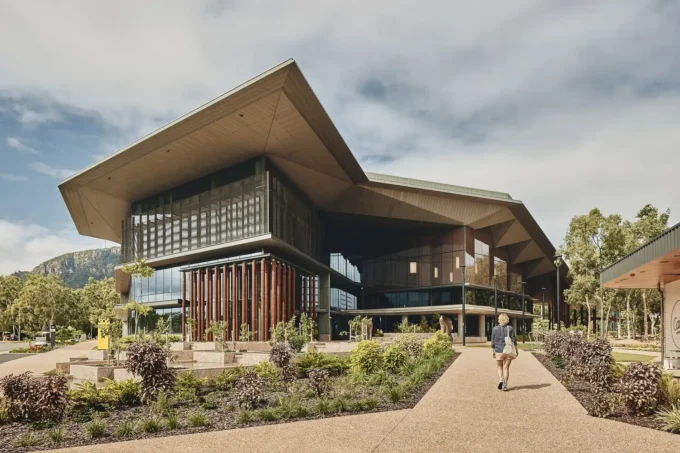Responding to the evolving identity of Lawrence Technological University (LTU), INFORM Studio has designed a flagship student residence that transforms the campus’s spatial fabric and redefines the on-campus student experience. The East Residence Hall is more than just a housing project—it is a dynamic architectural catalyst that reflects LTU’s cultural shift from a commuter institution to a vibrant, residential university embracing diversity, community, and student well-being.

A New Identity for a Growing Campus
In recent years, LTU has witnessed a remarkable transformation in its student demographics and campus culture. Driven by the introduction of varsity athletics and a notable increase in international student enrollment, the university has evolved from its commuter-school roots into a more immersive academic environment. This shift generated an urgent demand for high-quality, on-campus housing options that not only accommodate students but actively enrich their university experience.
Situated at the heart of the Southfield campus, the new 300+ bed East Residence Hall is a response to this need and now serves as the university’s residential flagship. It plays a critical role in student recruitment and has quickly become central to the daily life of both domestic and international students. Beyond serving as a dormitory, the building embodies the university’s long-term vision for a cohesive, lively, and pedestrian-oriented campus.
Connecting Campus Districts Through Design
Strategically located at the convergence of three previously disconnected campus zones, East Residence Hall introduces a strong urban strategy that stitches the university fabric together. Prior to its development, LTU lacked a clear central spine or civic identity—especially within its residential district. INFORM Studio tackled this issue by reimagining the project as both a building and a connective urban gesture.
The design introduces a central pedestrian corridor that runs through the building, linking the north and south districts of the campus. This linear path not only enhances physical circulation but also creates a courtyard experience, anchoring student life around social interaction, visual connectivity, and informal learning. The East Residence Hall thus becomes a bridge—spatially and symbolically—between the old and new narratives of the university.

A Living Lab for Community and Learning
Community-building was a primary design driver. INFORM Studio’s design integrates eleven distinct programmatic layers that support various aspects of student life—ranging from academics to recreation. These include dedicated spaces for learning, collaboration, fitness, entertainment, music, wellness, and nutrition. Each program element is intentionally distributed throughout the building, creating a vertical and horizontal weave of activity.
A computational design strategy informed the placement of these community zones. Using algorithms to analyze circulation paths, daylight access, program adjacency, and façade rhythm, the design team achieved a balanced three-dimensional distribution of shared spaces. These spaces are strategically located at points of natural student flow, enhancing spontaneous interaction while preserving privacy for individual rooms.
Interior Experience and Human-Centered Design
The building is designed not just as a backdrop to student life, but as a facilitator of it. At every level, students are given access to communal lounges, group study zones, kitchens, and recreation areas. Informal breakout areas along corridors serve as micro-communities, while larger, daylight-filled lounges function as central gathering points.
The interiors are characterized by warm, contemporary materials, robust yet inviting furniture, and integrated technology to support both individual and collaborative work. Acoustic considerations were critical in music and relaxation areas, while fitness zones are located near windows for natural light and ventilation. The design speaks to both the diversity of student needs and the importance of creating spaces where students can thrive emotionally, socially, and intellectually.

Architecture as a Recruitment and Retention Tool
East Residence Hall plays a pivotal role in shaping first impressions for prospective students and their families. Its bold design, user-friendly programming, and sense of openness contribute directly to LTU’s recruitment efforts. More importantly, it supports student retention by offering a holistic living environment that nurtures academic success, personal growth, and a strong sense of belonging.
Towards a More Cohesive Campus Future
Ultimately, the East Residence Hall is a transformative project—not only for Lawrence Technological University but also for the broader conversation around student housing in the 21st century. INFORM Studio has crafted an architectural response that moves beyond the traditional dormitory typology, instead embracing a model of hybrid functionality and urban connectivity. The building enhances the daily lives of students while establishing a new campus identity rooted in inclusivity, vibrancy, and human-centered design.
Photography: Steve Kroodsma
- Academic housing with social spaces
- Architecture for student engagement
- College recruitment architecture strategy
- Community-driven dormitory layout
- computational design in architecture
- Contemporary student residence design
- East Residence Hall LTU
- First-year student housing LTU
- Human-centered student housing
- INFORM Studio student housing
- Integrated student life design
- Lawrence Technological University dormitory
- Mixed-use student living architecture
- Modern dormitory interior design
- Pedestrian-oriented campus design
- Residential campus transformation
- Student housing with wellness spaces
- Student residence with fitness facilities
- University housing for international students
- Urban campus planning architecture






























Leave a comment